



Sir Richard Pembridge (died 1375), KG, was one of the earliest appointed Knights of the Garter.




Sir Richard Pembridge (died 1375), KG, was one of the earliest appointed Knights of the Garter.
A Herefordshire man whose family background is uncertain, he fought at sea at the Battle of Sluys (1340) and alongside King Edward III at the Battle of Crécy (1346) and at the Battle of Poitiers (1356) during the Hundred Years' War. He served the king as Custodian of Southampton Castle in 1361 and then as Constable of Dover Castle and Warden of the Cinque Ports in 1370. [3] He was appointed a Knight of the Garter in 1368. In 1372 he refused to accept the post of Lieutenant of Ireland and as a result was in some disgrace at his death in 1375.
He married Elizabeth le Strange (d.1362), a daughter of John le Strange, 2nd Baron Strange (1305–1349), of Blackmere, by his wife Ankaret le Boteler, daughter of William Boteler, 1st Baron Boteler (died 1334), of Wem. Elizabeth was the widow successively of Edmund St John, 3rd Baron St John (d. 1347), of Basing, who died at the Siege of Calais in 1347, and of Gerard de Lisle, 1st Baron Lisle (1304-1360)of Kingston Lisle. By Elizabeth he had one son:
He was buried in the Black Friars Monastery in Hereford. As he died without surviving issue his eventual heirs were his nephews Sir Richard Burley and Sir Thomas de Barre.
His monument with recumbent effigy was originally situated in the Black Friars Monastery in Hereford, but following the Dissolution of the Monasteries [1] was moved to its present location in Hereford Cathedral. He is sculpted in life-size in alabaster, fully armed and wearing the Garter on his left leg below the knee. [4] Fisher (1898) wrote: [5]
His steel helm, one of only four 14th-century knight's helms to survive, is held at the National Museum of Scotland in Edinburgh. [2]

The Most Noble Order of the Garter is an order of chivalry founded by Edward III of England in 1348. It is the most senior order of knighthood in the British honours system, outranked in precedence only by the Victoria Cross and the George Cross. The Order of the Garter is dedicated to the image and arms of Saint George, England's patron saint.

Sir Roger de Mortimer, 2nd Earl of March, 4th Baron Mortimer of Wigmore, KG was an English nobleman and military commander during the Hundred Years' War.
Baron Lisle was a title which was created five times in the Peerage of England during the Middle Ages and Tudor period, and once in the Peerage of Ireland in the 18th century.
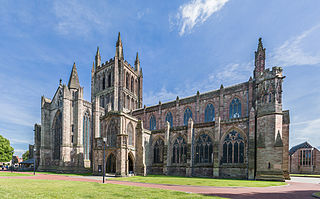
Hereford Cathedral is the cathedral church of the Anglican Diocese of Hereford in Hereford, England.
Robert Ferrers of Wem. He was born in Willisham, Suffolk.
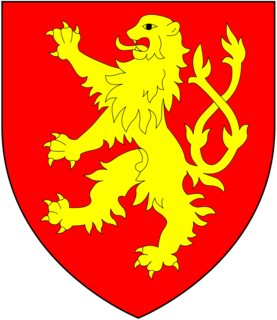
Bartholomew Burghersh, 1st Baron Burghersh, called "the elder", was an English nobleman and soldier, a younger son of Robert Burghersh, 1st Baron Burghersh and Maud Badlesmere, sister of Bartholomew Badlesmere, 1st Baron Badlesmere. He was the father of Bartholomew Burghersh the younger.

John Devereux, 1st Baron Devereux, KG, was a close companion of Edward, the Black Prince, and an English peer during the reign of King Richard II.

Thomas Manners, 1st Earl of Rutland, 12th Baron de Ros of Helmsley, KG, of Belvoir Castle, Rutland, was created Earl of Rutland by King Henry VIII in 1525.
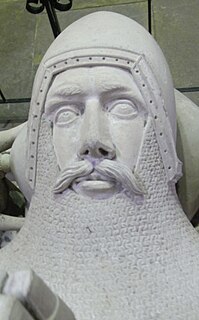
Sir Hugh de Courtenay, 2nd/10th Earl of Devon, 2nd Baron Courtenay, feudal baron of Okehampton and feudal baron of Plympton, played an important role in the Hundred Years War in the service of King Edward III. His chief seats were Tiverton Castle and Okehampton Castle in Devon. The ordinal number given to the early Courtenay Earls of Devon depends on whether the earldom is deemed a new creation by the letters patent granted 22 February 1334/5 or whether it is deemed a restitution of the old dignity of the de Redvers family. Authorities differ in their opinions, and thus alternative ordinal numbers exist, given here.

John de Lisle, 2nd Baron Lisle of Rougemont, KG was an English peer and soldier who spent much of his career serving in the wars in France. He was a companion of Edward III, and one of the founding members of the Order of the Garter in 1348.
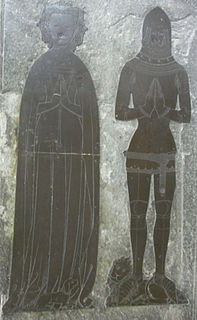
Thomas de Berkeley, 5th Baron Berkeley, The Magnificent, of Berkeley Castle and of Wotton-under-Edge in Gloucestershire, was an English peer and an admiral. His epithet, and that of each previous and subsequent head of his family, was coined by John Smyth of Nibley (d.1641), steward of the Berkeley estates, the biographer of the family and author of "Lives of the Berkeleys".
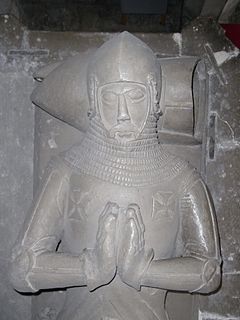
Maurice de Berkeley, 4th Baron Berkeley, The Valiant, feudal baron of Berkeley, of Berkeley Castle in Gloucestershire, was an English peer. His epithet, and that of each previous and subsequent head of his family, was coined by John Smyth of Nibley, steward of the Berkeley estates, the biographer of the family and author of "Lives of the Berkeleys".

Gerard II de Lisle, 1st Baron Lisle of Kingston Lisle, was an English nobleman and soldier during King Edward III's campaigns in Scotland and France.

Margaret de Bohun, Countess of Devon was the granddaughter of King Edward I and Eleanor of Castile, and the wife of Hugh Courtenay, 10th Earl of Devon (1303–1377). Her seventeen children included an Archbishop of Canterbury and six knights, of whom two were founder knights of the Order of the Garter. Unlike most women of her day, she received a classical education and was a lifelong scholar and collector of books.

Sir Hugh Courtenay, KG, was the eldest son and heir apparent of Hugh Courtenay, 10th Earl of Devon (1303–1377), whom he predeceased, and was a founding member of the Order of the Garter.

Sir Neil Loring, KG, was a medieval English soldier and diplomat and a founding member of the Order of the Garter, established by King Edward III in 1348. The central character in two historical novels by Sir Arthur Conan Doyle, Sir Nigel and The White Company, is loosely based on Neil Loring.

The Holland family was a medieval-era English noble family. Many Hollands were Earls, Dukes, Knights and Barons in medieval England, and they played significant roles in the struggles for the crown in fourteenth and fifteenth century.
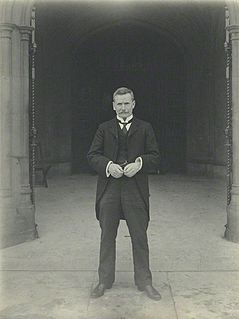
Sir William Henry St John Hope (1854–1919) was an English antiquary.

Alexander Denton of Hillesden in Buckinghamshire was a landowner and member of the Buckinghamshire gentry. He is best known for his two monuments, one in Hereford Cathedral the other in Hillesden Church.

Baron Cantilupe was a title created in the peerage of England by writ on 29 December 1299 addressed to Willelmo de Canti Lupo or Cauntelo,.
| Wikisource has original text related to this article: |